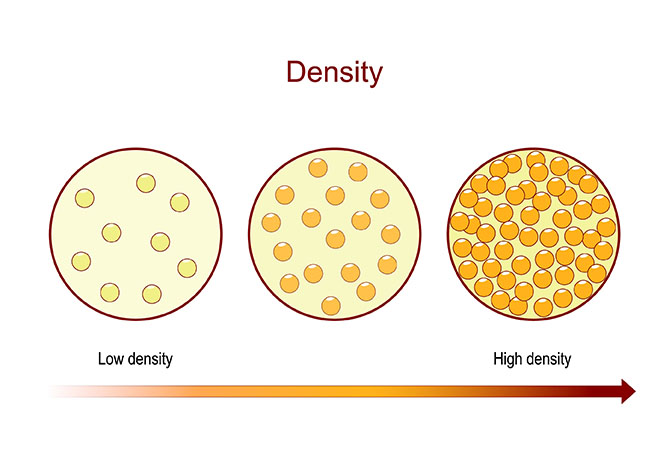
< Back
density
Definition
Density is the amount of mass in a given volume. It is a measure of how tightly packed the particles of a substance are. The denser a substance is, the more mass it has in a given volume.
Density is measured in grams per cubic centimetre (g/cm3) or kilograms per cubic meter (kg/m3). For example, the density of water is 1 g/cm3, which means that 1 cubic centimetre of water has a mass of 1 gram.
Density can be used to determine the volume of a substance if you know its mass, or vice versa. It can also be used to compare the densities of different substances.
For example, the density of gold is 19.3 g/cm3, which is much denser than the density of water. This means that a gold bar with a volume of 1 cubic centimetre will have a mass of 19.3 grams, while a water balloon with the same volume will have a mass of only 1 gram.
Density is an important property of matter, and it has many applications in science and engineering. For example, density is used to determine the buoyancy of objects, which is how well they float in water. It is also used to calculate the amount of force needed to push or pull an object through a fluid, such as water or air.
How can the word be used?
The density of the water is 1 gram per cubic centimeter.

Different forms of the word
Noun: density (plural: densities).
Adjective: dense.
Verb: to densify.
to make something denser.
Etymology
The word "density" comes from the Latin word densitas, which means "thick" or "closely packed". It was first used in English in the 14th century to refer to the amount of matter in a given volume.
Question
Why is density something which impacts a materials ability to float?
AQA Science Exam Question and Answer
Question:
Describe the concept of density and how it affects the behaviour of objects in different mediums. Provide examples to support your explanation.
Answer:
- Density is a fundamental property of matter that describes how much mass is packed into a given volume of a substance. Mathematically, it is expressed as density (ρ) = mass (m) / volume (V). When an object is denser than the medium it is placed in, it will sink, while a less dense object will float.
- For instance, consider a steel ball and a ping pong ball of the same volume. The steel ball is denser than water, so when placed in a container of water, it sinks. In contrast, the ping pong ball, being less dense than water, floats on its surface.
- Density also explains why substances layer in a specific order when mixed but not dissolved. In a classic oil and water mixture, oil, being less dense than water, floats on top since it does not mix with water due to its differing densities.
In conclusion, understanding density is crucial in explaining the behaviour of objects in different mediums and why certain substances separate or mix based on their density differences.